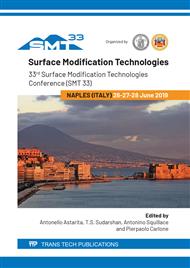p.399
p.404
p.411
p.417
p.423
p.429
p.435
p.441
p.447
Cold Spray for Additive Manufacturing: Possibilities and Challenges
Abstract:
Cold spray (CS) is a deposition technique to form a coating from the particles with temperature lower than their melting point. In this technique, particles are accelerated by a supersonic flow of a carrier gas such as air or nitrogen. Upon impact, particles undergo significant plastic deformation that bonds them to the substrate. Since the particles are not molten, this deposition method does not apply a lot of heat to the substrate and this makes CS the best candidate for temperature sensitive and oxygen sensitive materials. CS can be adapted to form 3D objects following layer-by-layer approach. This is called cold gas dynamic manufacturing (CGDM) or cold spray as additive manufacturing. Developing complex shapes by CGDM may result in formation of inclined surfaces, corners and sharp edges. Deposition in those regions is often accompanied with challenges that affect the accuracy and efficiency of the manufacturing. In this study, CGDM for two typical shapes such as cylinder and frustum on a flat substrate has been simulated to represent the additively manufactured parts. Particle trajectories and impact conditions i.e. velocity and size distributions have been compared. The results of numerical modelling provided useful information for understanding the limitations and challenges associated with CGDM that can help us to improve the quality and precision of particle deposition.
Info:
Periodical:
Pages:
423-428
Citation:
Online since:
July 2019
Authors:
Keywords:
Price:
Сopyright:
© 2019 Trans Tech Publications Ltd. All Rights Reserved
Share:
Citation:



